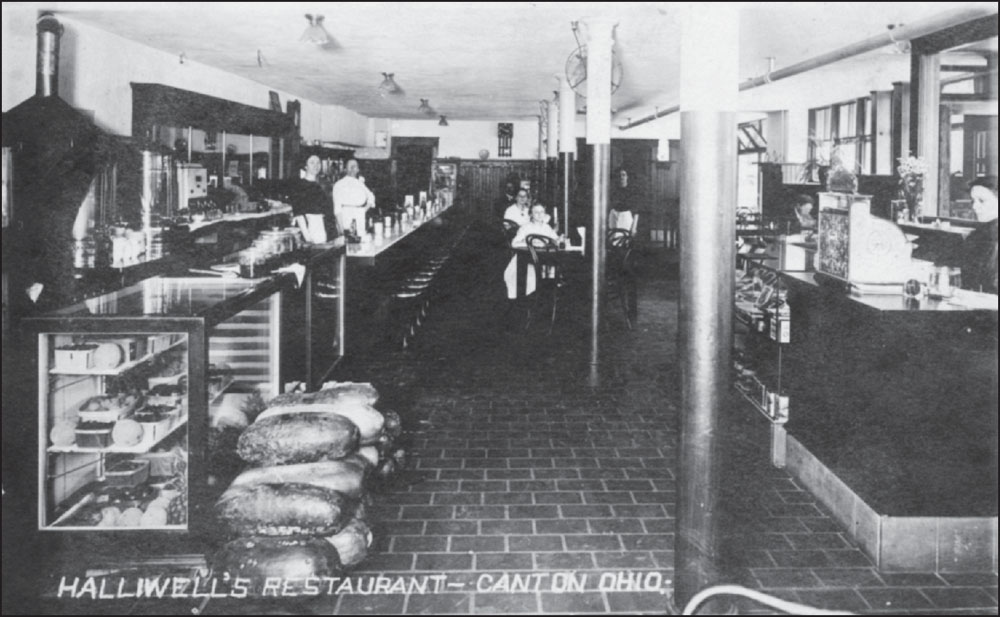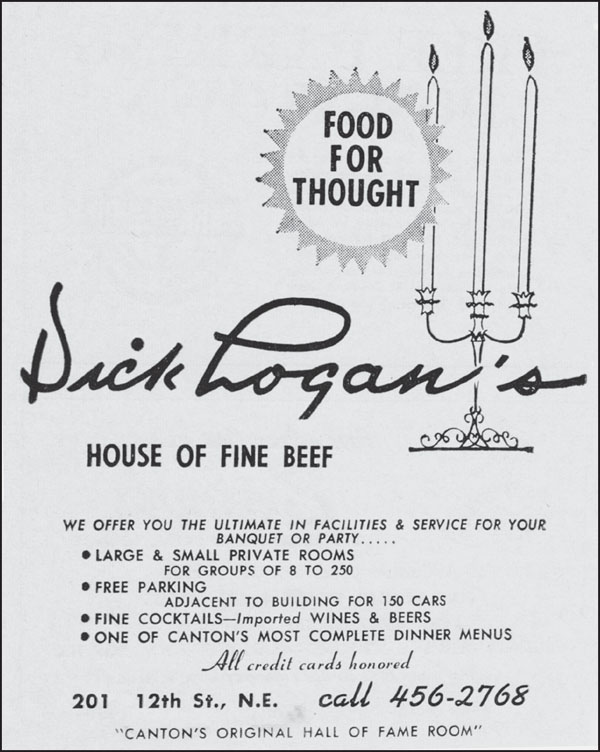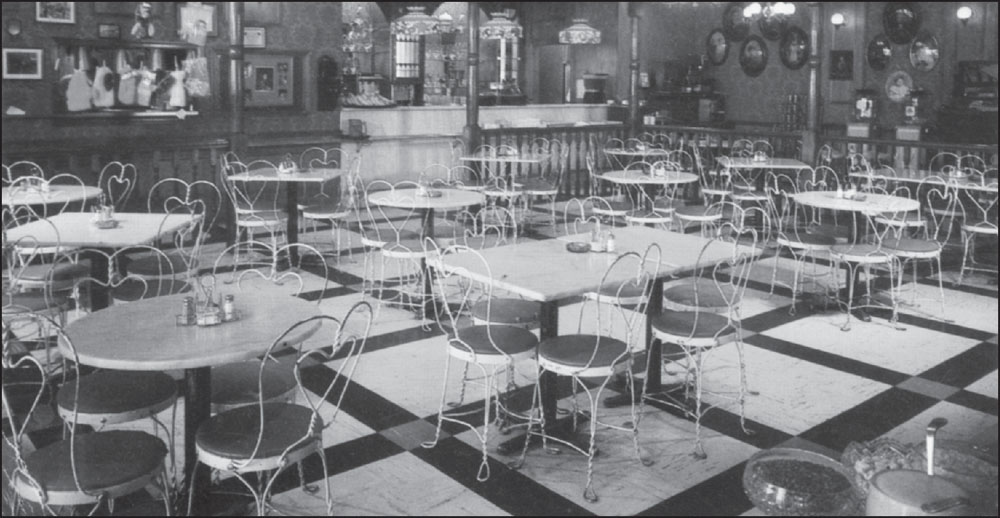
Little’s Model Dining Hall was located at 224 East Tuscarawas Street. Their sign advertised a “good warm meal for 25¢.” They also offered meals “at all hours” and offered choice cigars, hot coffee, cold lunches, and ice-cold milk by the glass.
Seven
RESTAURANTS

Little’s Model Dining Hall was located at 224 East Tuscarawas Street. Their sign advertised a “good warm meal for 25¢.” They also offered meals “at all hours” and offered choice cigars, hot coffee, cold lunches, and ice-cold milk by the glass.

In the Victorian era, oysters were a popular menu item at many restaurants. Little’s, which appears in only the 1895 Canton city directory, advertised “fresh NY count oysters always on hand” in all seasons.

Ed and Anna Bender opened their well-known restaurant in 1902 at the corner of East Tuscarawas Street and Walnut Avenue. In 1907, it moved to its present location in the Belmont Building, which was designed by architect Guy Tilden. In spite of a major fire in 1988, the original bar is still intact.

This advertisement from 1918 points out that “positively no liquors” were served in the Ladies Restaurant. Saturday nights in the 1910s were often described as “nightmares” by the staff, who dreaded them all week long. Downtown stores were open late, and businessmen often had wives and children meet them for dinner. After an evening of shopping, they all came back for “chili and beer” and stayed well into the night. The Jacob family purchased the restaurant from Anna Bender in 1932. Today, it is run by the fourth generation of the family.

Halliwell’s was located at 13 East Tuscarawas Street near Public Square. The restaurant was “centrally located,” noted one Canton souvenir booklet in 1907, “yet above the din and noise of the street” because it was on the second floor. G.E. Halliwell “won a reputation for the best meals money can buy and where everything is clean and well cooked, meals served in good style, and every customer given prompt attention.” Halliwell also operated a lunch counter called the Exchange around the corner from his first restaurant. (Courtesy of the Stark County District Library.)

Roth & Hug was a popular corner drugstore and soda fountain in the early 20th century. In 1899, Charles R. Roth and Casimer K. Hug had bought a small drugstore at 333 East Tuscarawas Street from H.H. Ink, and they quickly grew their business into a local chain. This is the 435 East Tuscarawas Street location.

By 1922, there were at total of seven Roth & Hug locations in Canton: East Tuscarawas Street and Cherry Street NE, Market Avenue and Second Street NE, Cleveland Avenue and Twelfth Street NW, the Harris Arcade Building, Cherry Street and Second Street NE, Market and Sixth Street NW, and Tuscarawas Street and High Street SW. There was also a location in North Canton.

In 1917, Roth & Hug ran the following advertisement: “We have sold 5-cent soda for seventeen years and it is with regret that we find a good ice-cream soda can no longer be served for that amount. Fruit, fruit juices, flavors, sugar, ice cream, service, all have been steadily advancing for years . . . we have to do one of two things—cheapen quality or raise the price . . . so we are forced to serve 10-cent soda.”

The first effort at creating a resort at Meyers Lake began in 1879 when Joseph A. Meyer, grandson of Andrew Meyer, built the Lake Park Hotel. Like so many early ventures, the hotel burned down in 1892. It was rebuilt by the Reymann Brewing Company and was then sold to the Northern Ohio Traction & Light Company, who leased it to the Lakeside Country Club in 1903. The country club’s dining room is shown here.

Before shifting gears and starting an all-you-can-eat restaurant called Town and Country, Mary and Tully Foster ran the Club Casablanca at the same location (5079 West Tuscarawas Street) from 1942 to 1957, hosting such big-name stars as Lawrence Welk and Patti Page. Once television began to replace live shows, the Fosters decided to switch gears. They had seen a buffet in a hotel in Toronto where the chefs served the food in the style of a cafeteria, and they decided to give it a try here.

When the Fosters opened their famous buffet Town and Country in 1957, it was the first of its kind in the area. Serving fantastic food and charging just $2.50 per person, the crowds started to become a problem. They actually raised their price to try to reduce the number of customers. Town and Country closed in 1987 when the Fosters retired, and the building was razed in 2001. (Courtesy of Linda Todd.)

Founded by Nick Zenallis in 1956, Nick’s Place Topp’s Chalet was one of the first businesses built in what would become the bustling Belden Village area, at 5401 Whipple Avenue NW. It was a fine-dining establishment where people often went to celebrate special occasions. The restaurant burned down in May 1994 and was not rebuilt.

Emmanuel “Mike” Elite and George Bourlas ran the Elite Restaurant at 206 West Tuscarawas Street from 1932 until 1957. It was open 24 hours a day, with each partner taking a 12-hour shift. Tommy Dorsey, Guy Lombardo, Desi Arnaz, and Howard Hughes were just a few of the familiar names who ate at the Elite. During the Depression, the owners were known to feed people who were down on their luck from the back door. (Courtesy of Jim McVay.)

A native of Greece, Frank Michael Mergus began his career as a kitchen boy in Boston’s Hotel Touraine when he was just 14. Shortly after coming to Canton, he started working at Bender’s in 1923. In 1930, he went to work at the Onesto Hotel as a caterer. In 1943, he opened Mergus Restaurant at 225 West Tuscarawas Street. One advertisement stated that Mergus was “known everywhere as one of Ohio’s outstanding restaurants.”

The most popular dishes at Mergus were prime rib, lobster, and charcoal-broiled steaks. The restaurant became known as a special place to host wedding receptions, engagement dinners, and banquets. In the 1960s, pianist Betty Geouge entertained diners nightly. After Mergus’s death in 1980, the restaurant was sold. It continued to operate under new ownership for three years before closing. (Courtesy of Linda Todd.)

The first drive-in carhop-service restaurant in the area was Avalon’s, located at the time quite a distance out of town on Cleveland Avenue, north of Thirtieth Street. Brothers A.A. “Sykes” and Gerald Thoma built it in 1935 and named it after a Pacific Island paradise they had heard about on a visit to the west coast. The menu featured frozen custard (a novelty at the time), sandwiches, and their signature burger, “Big Sis.” Cruising was elevated to an art form in the 1950s, and kids would “Buzz the A” to see what was going on, even if they did not have any money or were not particularly hungry. The Avalon closed in the 1970s to make room for a Wendy’s. (Courtesy of the Canton Classic Car Museum.)

There were two other Avalon locations, one at Ninth Street and North Market Avenue, shown here, and another at Dueber Avenue and West Tuscarawas Street. (Courtesy of Jim McVay.)

This 1949 Avalon children’s menu came from the North Market location. Main-entrée options were creamed chicken or roast veal with a starter of beef rice soup, sides of buttered peas and whipped potatoes, and a choice of tomato juice or apricot nectar—much different from modern children’s menus featuring hot dogs and chicken nuggets. (Courtesy of Dawn Walter.)

The Kozy Kitchen was located on the southwest corner of West Tuscarawas Street and Dueber Avenue, where Lindsey’s is now located. Like many drive-ins, there were carhops at the Kozy Kitchen, but customers could also eat inside the air-conditioned dining room. It was one of many teen hangouts in the 1950s and 1960s. (Courtesy of Linda Todd.)

Eckard’s, located at the corner of West Tuscarawas Street and Linwood Avenue SW, was a popular hangout for Lincoln High School kids. In 1949, Eckard’s became the first in the area to have carhops on roller skates who served patrons in their cars. Alternatively, customers could go inside and eat at a booth. In the 1960s, one could get a Coke and French fries for 35¢. Eckard’s closed in 1968, when drive-ins were beginning to be replaced by drive-throughs. (Courtesy of Jim McVay.)

With a beautiful view of Meyers Lake, the Lakeshore Restaurant was conveniently located adjacent to the Moonlight Ballroom, providing the setting for an ideal date night. George C. Sinclair opened the restaurant in August 1961, and it featured dining and cocktails all year round. The restaurant closed in August 1976 but later reopened as Clancy’s. It was destroyed in the January 1979 fire that engulfed the Moonlight Ballroom. (Courtesy of Linda Todd.)

This advertisement appeared in the program for the Grand Encampment and Department Council of the Independent Order of Odd Fellows (IOOF) in July 1921. It shows the variety of dining options available in downtown Canton at that time, including Bender’s, the YMCA Cafeteria, the Hotel Courtland, the New Barnett Restaurant and Dairy Lunch, the Grand Restaurant, Bates’ Candy Shop, Crescent Restaurant, Manhattan Restaurant, the Horse Shoe Dairy, Jersey Restaurant, and the Palace Restaurant. (Courtesy of the Canton Classic Car Museum.)

Peter and Mary Edna Welden opened the first Mary Ann Donuts location at 1009 McKinley Avenue NW in 1947. It was named for the couple’s first child, Mary Ann. A second location opened on West Tuscarawas Street in 1984. The family-owned local chain has grown to seven stores in Stark County, and their donuts can be found in a variety of convenience stores and gas stations throughout Northeast Ohio. According to this advertisement from 1962, a dozen Mary Ann donuts cost just 60¢. (Courtesy of Linda Todd.)

Dick Logan’s was located at 201–203 Twelfth Street NE. The family’s original name, Lougash, was Americanized to Logan. In 1969, the booklet Around Town said, “The piano bar at Dick Logan’s is alive nightly under the talents of Gene Wygant. The personable pianist covers the gamut on the musical scale from blues, jazz to old-time favorites. If you feel like singing, join in, everybody else does.” (Courtesy of Linda Todd.)

At the Linway, customers could order “a complete meal or just a snack.” They were well known for their freshly baked pastries. The Linway was located at 5103 West Tuscarawas Street, one mile west of Canton, and it appeared in the Canton city directory from 1942 to 1956. (Courtesy of Jim McVay.)

The Candy Bowl was a favorite stop after a long day of shopping or catching a movie in one of the downtown theaters. The sandwich shop and ice-cream parlor was located at 330 North Market Avenue and was open from 1950 to 1973. (Courtesy of the Stark County District Library.)

The Boston Restaurant, located at 1318 West Tuscarawas Street, appeared in the Canton city directories from 1924 to 1942. (Courtesy of Dawn Walter.)

Located at 2231 Forty-fourth Street NW, the Pines was a favorite spot for weddings from the 1950s through the mid-1980s. John Salby, the original owner, lived upstairs and later built a house next door. From 1984 to 1989, Ron Kern ran a restaurant called Whitehouse Chicken in the space. Michelle and Shawn McCartney purchased the building in 1991 and, after six months of renovation, they reopened as Chateau Michele on their wedding day, February 14, 1992. The banquet hall is a popular spot for wedding receptions, parties, meetings, and catering. (Courtesy of Chateau Michele.)

Originally opened as a Barnhill’s franchise in 1970, the ice-cream parlor at 4216 Hills & Dales Road NW became Butler’s in 1975. The restaurant was decorated in 1890s style, with wrought-iron chairs, marble-top tables, and Tiffany lamps. The restaurant was known for its extra-large menu items. A “Party Soda” was served in a one- or two-gallon brandy snifter with a 36-inch-long straw for each person. The “Sociable Soda” was available for two, four, eight, or twelve people. And the colossal “Hall of Fame Sundae” fed 50 to 75 people, with nine gallons of ice cream, one and a half gallons of syrup and toppings, four cans of whipped cream, a quart of cherries, and a dozen bananas. Butler’s closed in 1988. (Courtesy of the Stark County District Library.)

Taggart’s was founded in 1926 at 1401 Fulton Road NW, where it still operates today. The beloved ice-cream parlor is famous for the Bittner, a Canton favorite since 1931. Named for a delivery boy, the secret mix of vanilla ice cream, chocolate syrup, and pecans creates a dessert that is the consistency of a milkshake but thick enough to eat with a spoon. The Bittner comes in two sizes: regular or the mini version shown here. (Courtesy Barbara Abbott, Canton Food Tours.)